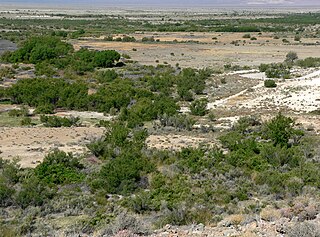 W
WThe Ash Meadows National Wildlife Refuge is a protected wildlife refuge located in the Amargosa Valley of southern Nye County, in southwestern Nevada. It is directly east of Death Valley National Park, and is 90 mi (140 km) west-northwest of Las Vegas.
 W
WAstragalus phoenix is a rare species of milkvetch known by the common name Ash Meadows milkvetch. It is endemic to Nye County, in southwestern Nevada.
 W
WCyprinodon nevadensis is a species of pupfish in the genus Cyprinodon. The species is also known as the Amargosa pupfish, but that name may also refer to one subspecies, Cyprinodon nevadensis amargosae. All six subspecies are or were endemic to very isolated locations in the Mojave Desert of California and Nevada.
 W
WThe Desert National Wildlife Refuge is a protected wildlife refuge, administered by the U.S. Fish and Wildlife Service, located north of Las Vegas, Nevada, in northwestern Clark and southwestern Lincoln counties, with much of its land area lying within the southeastern section of the Nevada Test and Training Range. The Desert NWR, created on May 20, 1936, is the largest wildlife refuge in the lower 48 states of the United States, encompassing 1.615 million acres (6,540 km2) of the Mojave Desert in the southern part of Nevada. This Range is part of the larger Desert National Wildlife Refuge Complex, which includes the Ash Meadows National Wildlife Refuge, the Moapa Valley National Wildlife Refuge, and the Pahranagat National Wildlife Refuge.
 W
WDevils Hole is a geologic formation located within the Ash Meadows National Wildlife Refuge, in Nye County, Nevada, in the Southwestern United States.
 W
WThe Devils Hole pupfish is a critically endangered species of the family Cyprinodontidae (pupfishes) found only in Devils Hole, a water-filled cavern in the US state of Nevada. It was first described as a species in 1930 and is most closely related to C. nevadensis and the Death Valley pupfish. The age of the species is unknown, with differing analyses offering ranges between one thousand and sixty thousand years. It is a small fish, with maximum lengths of up to 30 mm (1.2 in). Individuals vary in coloration based on age and sex: males are bright metallic blue while females and juveniles are more yellow. A defining trait of this species its lack of pelvic fins. The pupfish consume nearly every available food resource at Devils Hole, including beetles, snails, algae, and freshwater crustaceans, with diet varying throughout the year. It is preyed on by the predaceous diving beetle species Neoclypeodytes cinctellus, which was first observed in Devils Hole in 1999 or 2000. Reproduction occurs year-round, with spikes in the spring and fall. Females produce few eggs, though, and the survivorship from egg to adult is low. Individuals live 10–14 months.
 W
WMentzelia leucophylla, known by the common name Ash Meadows blazingstar, is a rare species of flowering plant in the Loasaceae. It is endemic to southwestern Nevada, in the Western United States.
 W
WThe moapa dace is a rare cyprinid fish of southern Nevada, United States, found only in the warm springs that give rise to the Muddy River, and in the upper parts of the river. It is the only species of the monotypic genus Moapa.
 W
WThe Moapa Valley National Wildlife Refuge (MVNWR) is a protected wildlife refuge administered by the U.S. Fish and Wildlife Service, located in the Warm Springs Natural Area in the Moapa Valley of Clark County, Nevada. The refuge is east of Death Valley and 60 miles (97 km) northeast of Las Vegas, Nevada.
 W
WThe Muddy River, formerly known as the Moapa River, is a short river located in Clark County, in southern Nevada, United States. It is in the Mojave Desert, approximately 60 miles (97 km) north of Las Vegas.
 W
WNitrophila mohavensis is a rare species of flowering plant in the family Amaranthaceae known by the common name Amargosa niterwort. It is endemic to Nye County in southwestern Nevada and Inyo County, in eastern California.
 W
WThe Pahranagat National Wildlife Refuge is a protected wildlife refuge, at the southern end of the Pahranagat Valley and administered by the U.S. Fish and Wildlife Service. It is 90 miles (140 km) north of Las Vegas, Nevada, in Lincoln County, Nevada. The 5,380-acre (21.8 km2) refuge was created on August 16, 1963, and is part of the larger Desert National Wildlife Refuge Complex, which also includes the Ash Meadows National Wildlife Refuge, the Desert National Wildlife Refuge, and the Moapa Valley National Wildlife Refuge.
 W
WThe Tecopa pupfish is an extinct subspecies of the Amargosa pupfish. The small, heat-tolerant pupfish was endemic to the outflows of a pair of hot springs in the Mojave Desert of California. Habitat modifications and the introduction of non-native species led to its extinction in about 1970.
 W
WThe Warm Springs Natural Area, also known as the Warm Springs Ranch, is located near the Moapa Indian Reservation in Clark County, Nevada, at an elevation of 2,123 feet (647 m). The 1,179-acre (477 ha) area is owned by the Southern Nevada Water Authority (SNWA). The area is a natural oasis in the Mojave Desert. The oasis is fed by close to 24 natural warm springs and contains many naturally occurring California fan palms, creating an ecosystem normally limited to the "low" Colorado Desert and so unique to the "high" Mojave Desert. The springs are the headwaters for the Muddy River.
 W
WZeltnera namophila, known by the common name spring-loving centaury, is a rare species of flowering plant in the gentian family. It is endemic to the Amargosa Valley, in Nye County, southwestern Nevada.